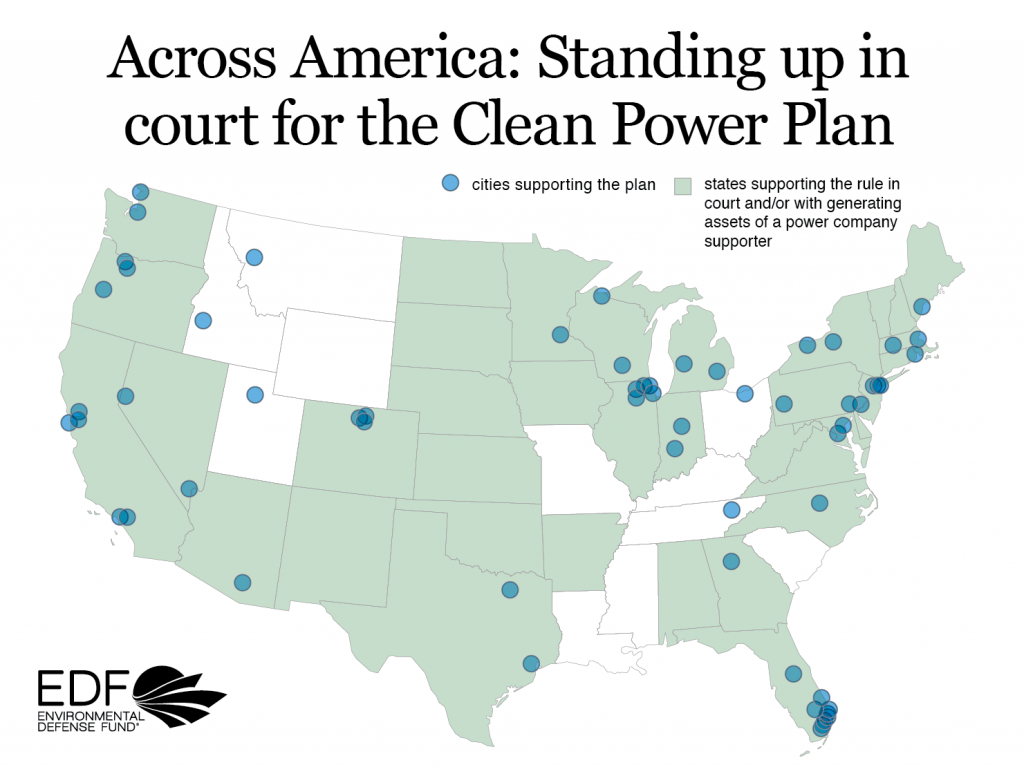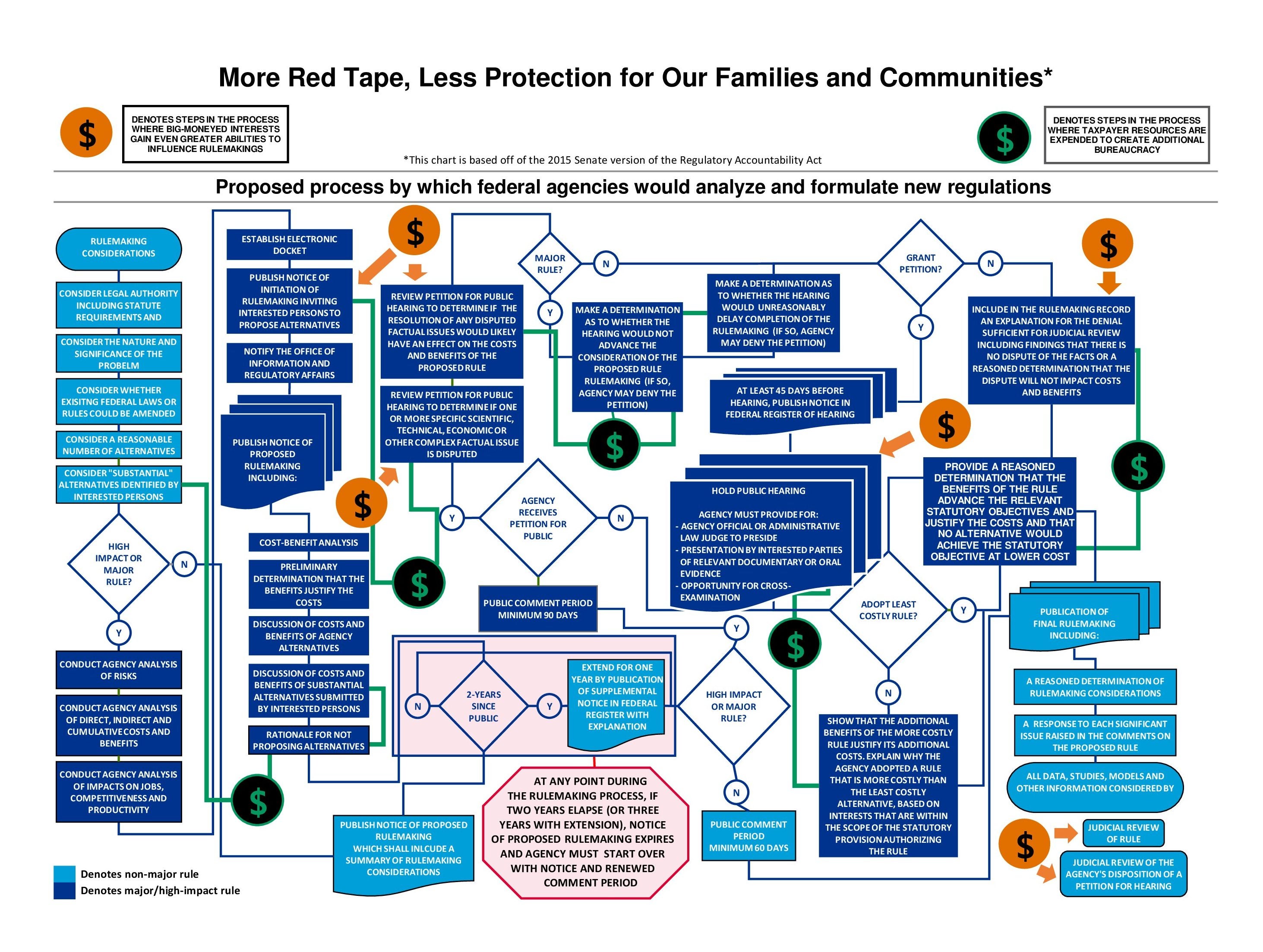
18 states, the District of Columbia, 60 municipalities and 11 utilities have filed in support of the Clean Power Plan
According to news reports, we may soon see an executive order designed to make the U.S. Environmental Protection Agency (EPA) revoke the Clean Power Plan, America’s first-ever nationwide limits on carbon pollution from power plants.
Revoking the Clean Power Plan would be monumentally bad public policy, placing our families and communities at greater risk from the dangers of climate change and threatening America’s vibrant clean energy potential.
But to fully understand all the reasons revoking the Clean Power Plan is the wrong choice, it’s important to dig into the facts – which demonstrate that the Clean Power Plan is broadly supported, bolsters economic vitality, and fosters America’s tremendous momentum in reducing carbon pollution from the power sector.
It’s especially important to dig into the facts now, because we can’t have confidence in what we’ll hear from EPA Administrator Scott Pruitt whenever this announcement is made.
- Yesterday, in an interview with CNBC, Pruitt denied that carbon dioxide is a primary contributor to global warming — contradicting NASA, VOAA, and well-settled science. Pruitt is known for mischaracterizing the science of climate change, doubling down in his written Senate testimony on some of the most widely debunked and discredited arguments put forward by climate skeptics.
- Pruitt has also repeatedly mischaracterized EPA’s rock-solid legal authority to address climate pollution – even though it’s supported by three straight Supreme Court opinions affirming that duty.
- Last week, it emerged that he misled the Senate during his confirmation process by falsely stating that he did not use his personal email account for official business.
Pruitt also has a long history of interwoven ties with big fossil fuel interests that stand to gain from undercutting common sense protections like the Clean Power Plan. He’s even been identified as leading an “unprecedented, secretive alliance” with them to oppose important safeguards.
So let’s dig in to the real facts on the Clean Power Plan, and better understand what’s at stake:
The Clean Power Plan Has Broad, Diverse Support Across the Country
The Clean Power Plan would reduce climate-destabilizing pollution from power plants – our nation’s largest source of this pollution – to 32 percent below 2005 levels by 2030.
It would save lives and protect public health as well, avoiding an estimated 3,600 premature deaths, 90,000 childhood asthma attacks, and 300,000 missed school and work days each year by 2030.
Its approach reflects the power sector’s already ongoing, market-driven transition to low cost, low carbon electricity, and is firmly anchored in law.
So it’s not surprising that it enjoys widespread support. In court, the Clean Power Plan is supported by a broad and diverse coalition that includes eighteen states and sixty municipalities across the country; power companies that own and operate nearly ten percent of the nation’s generating capacity; leading businesses like Apple, Google, Mars, and IKEA; public health and environmental organizations; consumer and ratepayer advocates; faith organizations; and many others.
Since November 2016, nearly 900 businesses and major investors have called on the new Administration to continue policies that address climate pollution —underscoring that “failure to build a low-carbon economy puts American prosperity at risk.” Signatories include DuPont, Gap Inc., General Mills, Hewlett Packard, Hilton, IKEA, Johnson & Johnson, The Kellogg Company, Levi Strauss & Co., L’Oreal USA, NIKE, Mars Incorporated, Pacific Gas and Electric, Schneider Electric, Sealed Air, Starbucks, Unilever, and many others. These signatories collectively earn almost $1.15 trillion in annual revenue, are headquartered across 44 states, and employ about 1.8 million people.
Large majorities of Americans, in red and blue states alike, support the Clean Power Plan and other actions to protect our families and communities from climate pollution. In a recent nationwide poll, 70 percent of Americans expressed support for the Clean Power Plan – including two-thirds of respondents in states that are challenging these vital protections.
Low-Carbon Energy Helps Fuel a Vibrant Economy
Reducing carbon pollution will create jobs and economic benefits across the country.
For everyday consumers, the Clean Power Plan incentivizes energy efficiency investments that save money. EPA estimates that by 2030, the average American family will save approximately $85 every year on their electric bill.
It also bolsters use of low-carbon power sources — which are already driving growth and vitality across the country. More than two million Americans now work in energy efficiency jobs, while solar and wind employ almost half a million people. Collectively, this represents more than twice the number of Americans employed through fossil fuel generation.
Clean energy investments frequently create jobs in low-income and rural communities that stand to benefit most. The American Wind Energy Association estimates that 70 percent of wind farms are located in low-income counties, and that wind developers currently pay $222 million a year in lease payments to U.S. farmers, ranchers and other rural landowners. The bi-partisan Governors’ Wind and Solar Coalition, led by Rhode Island Governor Gina Raimondo and Kansas Governor Sam Brownback, recently sent a remarkable letter to President Trump highlighting the impressive contributions of wind and solar to the American economy —particularly to low-income rural communities.
The Clean Power Plan Builds on — and Secures the Promise of — America’s Transition to Low-Carbon Energy
The Clean Power Plan’s targets are eminently achievable thanks to the powerful expansion of low-cost clean energy, which is increasingly out-competing other sources of electricity in the market. Rolling back the Clean Power Plan puts at risk America’s tremendous momentum and progress in reducing carbon pollution from the power sector.
Carbon pollution from the power sector has decreased by more than 20 percent since 2005, meaning that we’re already about two-thirds of the way toward meeting the Clean Power Plan requirements for 2030. In fact, most states that are litigating against the Clean Power Plan are on track to meet its requirements. Having the Clean Power Plan in place provides a policy framework and establishes an important, stable signal for investors—one that’s essential to make sure we build on the progress so far, and make strategic, sensible decisions for the long-term.
Clean energy is increasingly out-competing other sources of electricity — in particular, the market is seeing a surge in renewable energy development. One report estimated that 85 gigawatts of new wind and solar generation capacity will be added to the grid between 2016 and 2021. Thanks to dramatically declining costs, a recent extension of federal tax credits, and sustained technological advances, low carbon electricity is the increasingly preferred energy source. For example, from 2007 through 2015 alone, the price of solar photovoltaic modules fell by more than 80 percent. Meanwhile, coal-powered electricity is increasingly uneconomic compared to other forms of electricity, even without considering its substantial carbon pollution burden.
Consider these statements from power sector officials affirming their commitment to greater reliance on low-carbon power sources – made after the Nov. 2016 election:
- “It can’t just be, ‘We’re going to get rid of these regulations, and you guys can party until the next administration comes,’” Cloud Peak Energy Vice President Richard Reavey said. “There are serious global concerns about climate emissions. We have to recognize that’s a political reality and work within that framework.”
- “We’ve always had a point of view at Southern that there’s a reasonable trajectory in which to move the portfolio of the United States to a lower carbon future,” said Southern Company CEO Tom Fanning. “There’s a way to transition the fleet now.” In a later interview, Fanning added: “It’s clear that the courts have given the EPA the right to deal with carbon in a certain way.”
- “Regardless of the outcome of the election,” said Frank Prager, Xcel Energy’s Vice President of Policy and Federal Affairs, “Xcel Energy will continue pursuing energy and environmental strategies that appeal to policymakers across the political spectrum because we are focused on renewable and other infrastructure projects that will reduce carbon dioxide emissions without increasing prices or sacrificing reliability.”
And consider these actions by power companies to expand their renewable investments while phasing out high-carbon generation, putting them in a solid position to comply with robust carbon pollution regulations:
- Florida Power & Light (FPL) just announced it will install eight new solar power plants this year, building on its existing plants to expand reliance on low-carbon power sources. At the end of December 2016, FPL announced plans to shut down the recently-acquired 250-megawatt Cedar Bay coal plant at the end of the year. “I’m very proud of our employees for proposing this innovative approach that’s environmentally beneficial and saves customers millions of dollars,” said CEO Eric Silagy. FPL plans to replace the retired power with natural gas and solar — the company added 224 megawatts of solar capacity in 2016.
- On December 30, 2016, Southern Company announced an agreement with Renewable Energy Systems America to develop 3,000 megawatts of renewable energy scheduled to come online between 2018 and 2020. The agreement comes as Southern Company continued to boost its renewable portfolio with the acquisition of 300 megawatts of wind power in late December, bringing its total to more than 4,000 megawatts of renewable generation added or announced since 2012.
- PNM Resources spokesman Pahl Shipley said the company has no change in plans for replacing generation from retiring two units at a New Mexico plant, totaling 837 megawatts of capacity, with solar and nuclear power.
These developments make clear that continued progress towards a low-carbon future is within reach. The Clean Power Plan provides a sensible framework to help ensure we protect our communities and achieve the tremendous potential of America’s low-cost, low-carbon electricity resources.
The Clean Power Plan Provides a Path Forward that Will Protect and Strengthen American Communities
Let’s hope Scott Pruitt listens to the facts – and turns away from wrong-headed plans to stymie common sense climate protection. Moving forward on the Clean Power Plan will ensure the continuation of tremendous momentum towards a low-carbon future, save lives and improve public health, and help protect American families and communities from the worst ravages of climate change.
The Clean Power Plan is the right path forward for a stronger and safer America.











 This week has brought alarming indications that the Trump Administration is poised to roll back life-saving, common-sense climate protections with no plan for replacing them — and that the head of the U.S. Environmental Protection Agency (EPA) rejects basic facts about climate change and the clean air laws he is charged with carrying out.
This week has brought alarming indications that the Trump Administration is poised to roll back life-saving, common-sense climate protections with no plan for replacing them — and that the head of the U.S. Environmental Protection Agency (EPA) rejects basic facts about climate change and the clean air laws he is charged with carrying out.


